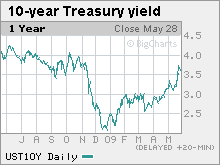Treasury prices rebound
Rally comes after a week of heavy debt issuance and intense price volatility.
NEW YORK (CNNMoney.com) -- The bond market rallied Friday at the end of a week with three major auctions of debt and sharp price swings.
The Treasury market worked through three major auctions this week totaling $101 billion. The market appeared relieved to have the hefty week of auctions behind it.
"They weren't spectacular, but they have gone by and the world didn't end," said Pierre Ellis, senior economist at Decision Economics. Going forward, "interest rates are going to be volatile and, as a result, prices are going to be volatile."
The auctions were center stage as investors tried to assess whether there is enough demand to continue funding the government's massive deficit spending program. On Wednesday, yields spiked, with the benchmark 10-year rate topping 3.7%, and the surge spooked Wall Street.
There is more debt in the pipeline, which will continue to pressure prices lower and yields higher.
Housing concern: But with key lending rates -- including the 30-year fixed mortgage rate -- tied to the benchmark, higher Treasury yields could stifle a recovery in the housing market.
The Federal Reserve and the Obama administration have been trying to stimulate the housing market, a critical artery in the economy. The bursting of the housing market bubble was the first shoe to drop in the recession that still plagues the global economy.
The Fed has been working to buy back its own debt to stimulate demand in the market and try to keep a cap on yields. But analysts say that the $300 billion campaign is not big enough to move the multi-trillion bond market.
While the Fed can step in and push Treasury yields lower temporarily, "given the volume of Treasurys being brought to market, they can't totally prevent an increase in rates," said Ellis. "There is going to be some rise in interest rates that they would be foolhardy to try to stop."
Rising bond yields can also be an indication of investor confidence. Investors tend to rush to the safety of government debt in times of market uncertainty.
Treasury prices have fallen sharply in the past few months, sending the yield higher. In mid-January, the benchmark yield was hovering between 2.25% and 2.40%. In recent sessions, the 10-year has surpassed 3.7% before easing back.
"The U.S. 10-year Treasury price is expected to work sideways to higher through May," said Nick Kalivas, vice president of financial research at MF Global, in a research note. "Yields are rising too fast for the pace of economic activity."
Even if Treasury prices rise in the short term, Ellis said that he expects that in the longer term, it will be yields that trend higher. "The economy should be improving and inflation will tend to firm up and the supply will be large," in the Treasury market, potentially threatening demand.
Bond prices: The benchmark 10-year note rose 31/32 to 96-29/32 and its yield edged down to 3.50% from 3.65% late Thursday.
The 30-year bond jumped 1-26/32 to 97-28/32 and its yield fell to 4.38% from 4.51%.
The 2-year note edged up 3/32 to 99-29/32 and its yield dipped to 0.94% from 0.98%. The yield on the 3-month note was unchanged at 0.14%.
Lending rates: One key bank-to-bank lending rate held at a record low. The 3-month Libor retreated back to 0.66% from 0.67% Thursday, according to Bloomberg.com.
Meanwhile, the overnight Libor rate rose to 0.27% from 0.26%.
Libor, the London Interbank Offered Rate, is a daily average of rates that 16 different banks charge each other to lend money in London. The closely watched benchmark is used to calculate adjustable-rate mortgages. More than $350 trillion in assets are tied to Libor. ![]()


